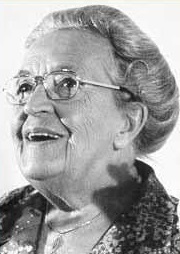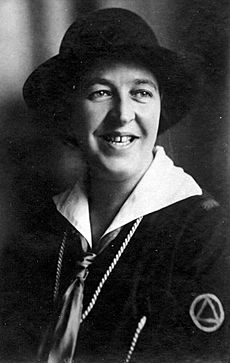Corrie ten Boom facts for kids
Quick facts for kids
Corrie ten Boom
|
|
|---|---|
 |
|
| Born |
Cornelia Arnolda Johanna ten Boom
15 April 1892 Haarlem, Netherlands
|
| Died | 15 April 1983 (aged 91) Placentia, California, U.S.
|
| Occupation | Writer, watchmaker |
| Known for | Author of The Hiding Place, Righteous Among the Nations |
| Parent(s) |
|
| Relatives | Betsie ten Boom (sister) Willem ten Boom (brother) Nollie van Woerden (sister) |
Cornelia Arnolda Johanna "Corrie" ten Boom (born April 15, 1892 – died April 15, 1983) was a Dutch watchmaker. She later became a Christian writer and speaker. Corrie worked with her father, Casper ten Boom, and her sister, Betsie ten Boom. They helped many Jewish people escape from the Nazis during World War II. They hid people in their home during the Holocaust, a time when Jewish people were greatly persecuted.
Sadly, Corrie and her family were caught. She was arrested and sent to the Ravensbrück concentration camp, a very harsh prison camp. Her most famous book, The Hiding Place, tells the story of her family's brave efforts. It also shares how she found and shared hope in God, even while she was imprisoned.
Contents
Corrie's Early Life
Corrie ten Boom was born on April 15, 1892, in Haarlem, Netherlands. She was the youngest child of Casper ten Boom, who was a jeweler and watchmaker. Her mother was Cornelia, often called "Cor." Corrie had three older brothers and sisters: Betsie, Willem, and Nollie. Her three aunts also lived with the family. Corrie's father loved making watches so much that he sometimes forgot to charge customers!
The Ten Boom family lived above Casper's watch shop. Corrie called their home "the Beje." This name came from the street they lived on, Barteljorisstraat. Corrie first helped with housework. But when her sister Betsie became sick, Corrie took her place in the watch shop. Corrie quickly found that she loved the "business side" of the shop. She set up a system for bills and records. Even after Betsie got better, Corrie stayed in the shop. Betsie then managed the housework, and both sisters were happy with this change.
Corrie trained to be a watchmaker herself. In 1922, she became the first woman in the Netherlands to get a license as a watchmaker. For the next ten years, she worked in her father's shop. She also started a club for teenage girls. This club taught them about faith, performing arts, sewing, and crafts. Corrie and her family were strong Christians. Their faith taught them to help others in need. They often gave shelter, food, and money to people. They believed that Jewish people were special to God and that all people are equal. These beliefs strongly motivated their brave rescue work later on.
Helping Others During World War II
In May 1940, the Germans invaded the Netherlands. One of their rules was to ban youth clubs like Corrie's. In May 1942, a well-dressed woman came to the Ten Booms' home. She was Jewish and told them her husband had been arrested. She was afraid to go home. She had heard the Ten Booms helped Jewish neighbors before. Casper Ten Boom quickly agreed to let her stay. Even though the police station was very close, he believed that "God's people are always welcome." The family became very active in the Dutch underground movement. They hid refugees and respected Jewish customs. They never tried to change the faith of the Jewish people who stayed with them.
Corrie and Betsie opened their home to Jewish refugees and members of the resistance movement. Because of this, the Gestapo (German secret police) looked for them. The Dutch Resistance learned about the Ten Booms' work. They sent an architect to build a secret room in their house. This room was next to the room where the Jewish people hid. They also added a buzzer to warn refugees to get into the room quickly. This secret room was called "The Hiding Place." It was in Corrie's bedroom, behind a false wall. Six people could hide there. A special ventilation system was put in for them.
Food was scarce during the war. Every non-Jewish Dutch person received a ration card to get food. Corrie knew many people in Haarlem from her charity work. She remembered a civil servant who was in charge of the local ration-card office. She visited him one evening. When he asked how many ration cards she needed, Corrie wrote in her book, "I opened my mouth to say, 'Five.' But the number that unexpectedly and astonishingly came out instead was: 'One hundred.'" He gave them to her, and she gave cards to every Jewish person she met.
Corrie's involvement in the Dutch resistance grew. She began to oversee a network that smuggled Jewish people to safe places. It is believed that Corrie's efforts saved about 800 Jewish people.
Arrest and Freedom
On February 28, 1944, a Dutch informant told the Nazis about the Ten Booms. Around 12:30 p.m. that day, the Nazis arrested the whole Ten Boom family. They were sent to Scheveningen Prison. The Nazis found resistance materials and extra ration cards in their home. But the six people hidden by the Ten Booms, both Jewish people and resistance workers, were not found. Even though the house was watched, police officers who were part of the resistance helped the hidden refugees escape. Corrie later received a letter in prison saying, "All the watches in your cabinet are safe." This meant the refugees had escaped and were safe. Four days after the raid, resistance workers moved them to other safe places. The Gestapo arrested over 30 people who were in the family home that day.
Most of the 30 people arrested were soon released. But Corrie, Betsie, and their father Casper were kept in prison. Casper died ten days later. Corrie was first held alone in a cell. After three months, Corrie and Betsie were sent from Scheveningen to Herzogenbusch, another prison camp. Finally, they were sent to the Ravensbrück concentration camp in Germany. This was a women's labor camp. There, they held worship services after long, hard days. They used a Bible they had managed to hide. Through the sisters' teachings and kindness, many prisoners became Christians. While at Ravensbruck, Betsie and Corrie started planning a place of healing for after the war.
Betsie's health got worse, and she died on December 16, 1944, at age 59. Before she died, she told Corrie, "There is no pit so deep that He [God] is not deeper still." Twelve days later, Corrie was released. She later learned that her release was a mistake. A week later, all the women in her age group were sent to the gas chambers.
Corrie returned home during a very difficult time called the "hunger winter." She still opened her doors to people with disabilities who were hiding.
After the War: Sharing Hope
After the war, Corrie returned to the Netherlands. She set up a special center in Bloemendaal to help people recover. This refuge housed survivors of the concentration camps. Until 1950, it only helped Dutch people who had worked with the Germans during the war and were now jobless. After that, it accepted anyone who needed care. In 1946, she went back to Germany. There, she met and forgave two Germans who had worked at Ravensbrück. One of them had been very cruel to Betsie.
Corrie then traveled the world as a public speaker. She visited more than 60 countries. She wrote many books during this time.
One of her books is called Tramp for the Lord. It was written in the late 1960s and early 1970s. Each chapter tells a short story about her travels. She shared her message of hope in Africa, Europe, the Americas, and Asia. She even visited difficult and dangerous countries like Russia (then the USSR), Cuba, and China. The book includes photos of Corrie and her important messages of forgiveness, hope, love, and salvation.
Corrie told the story of her family's World War II work in her bestselling book, The Hiding Place (1971). This book was made into a 1975 film, also called The Hiding Place. Jeannette Clift played Corrie, and Julie Harris played Betsie. In 1977, Corrie, at 85 years old, moved to Placentia, California. In 1978, she had two strokes. The first made her unable to speak, and the second caused paralysis. She died on her 91st birthday, April 15, 1983, after a third stroke. Corrie ten Boom was buried in Fairhaven Memorial Park in Santa Ana, California.
A sequel film, Return to the Hiding Place (War of Resistance), was released in 2011. This film was based on Hans Poley's book, which showed a wider view of the resistance group Corrie was part of.
Special Recognitions
- The Yad Vashem Remembrance Authority in Israel honored her on December 12, 1967. They named her Righteous Among the Nations. This title is given to non-Jewish people who risked their lives to save Jews during the Holocaust.
- The Queen of the Netherlands made her a knight. This was to recognize her brave work during the war.
- The Ten Boom Museum in Haarlem is dedicated to Corrie and her family. It honors their important work.
- The King's College in New York City named a new women's house after her.
Images for kids
More to Explore
 In Spanish: Corrie ten Boom para niños
In Spanish: Corrie ten Boom para niños




